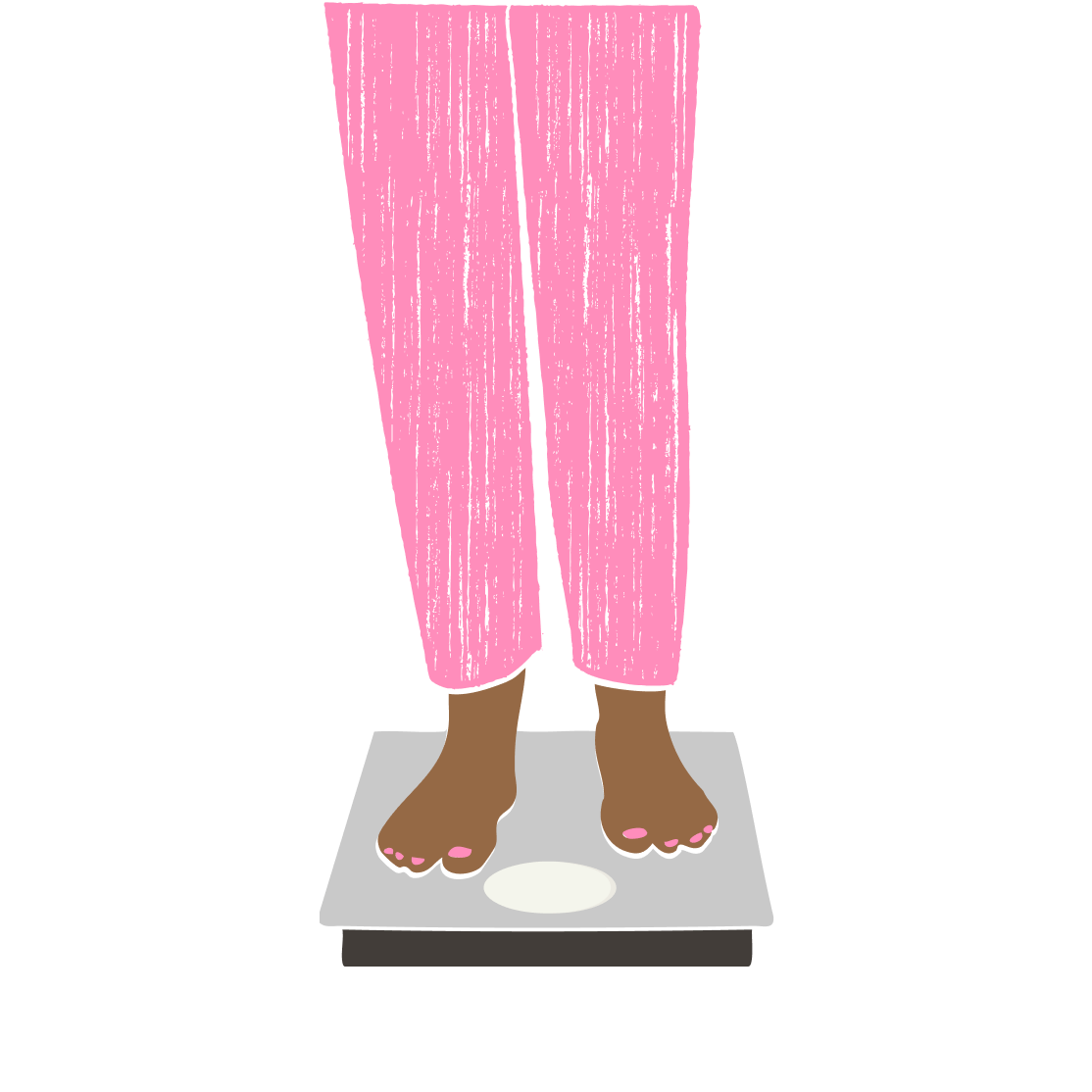How do you know if your pH balance is off? When your vaginal pH gets out of whack, you might notice things like changes in discharge, funky odors, itching and burning, or pain during sex. The culprit behind these changes could be anything from an infection to hormonal shifts during menopause (hello, declining estrogen), or even just your daily hygiene routine. Let's dive into what's going on with your pH and get you some clear answers. But remember: No matter what you're experiencing, you don't have to experience it alone. Healthcare professionals, like Midi clinicians, have seen—and treated—it all. Seek support so you don't suffer in silence.
Your vagina has been sending you some signals lately, and you're trying to figure out what's going on. Maybe things feel different down there, or you've noticed changes that have you wondering if everything's OK.
If your pH balance is off, chances are your vagina has been on your mind a lot lately. You're probably connecting the dots between changes in discharge, odor, and that nagging question: "Is this an infection, or is it hormonal?"
We totally get why you might hesitate to bring this up with your doctor or even a close friend. Vaginal health can feel like awkward territory. That's exactly why we're here to break it all down for you—no judgment, just facts.
What Is pH Balance in the Female Body?
Think back to high school chemistry for a hot second. The pH measures how acidic or alkaline something is on a scale of 0 to 14:
- Under 7: acidic
- At 7: right in the middle (neutral)
- Over 7: basic (alkaline)
This applies to a variety of substances. To put it in perspective, baking soda clocks in at 9.5, your urine and saliva hover around 6, and lemon juice and vinegar are sitting pretty at 2.
Your vagina likes to keep things on the acidic side, with a pH between 3.8 and 4.2. This slight acidity isn't just random—it's actually your body's brilliant way of maintaining vaginal health and keeping troublemaker organisms (including STIs) from setting up shop.

But here's where things can get tricky, especially if you're navigating menopause. As estrogen takes a nosedive during this transition, it messes with your vagina's pH game. Less estrogen in post-menopausal women means fewer lactobacillus bacteria (the good guys), responsible for producing lactic acid that keeps your pH in that sweet spot. When these helpful bacteria start slacking off, the not-so-great bacteria can take over, and boom—pH imbalance.
Signs and Symptoms Your pH Balance Might Be Off
Your pH might be off if you're dealing with a vaginal infection—think bacterial vaginosis, also known as BV (when bacteria throw a party); trichomoniasis (an STI); or genitourinary syndrome of menopause, or GSM (basically, your vaginal lining getting thinner due to hormonal changes).
Here are the symptoms of unbalanced pH levels to watch out for:
- Discharge drama: Your discharge might go rogue and show up as milky, clear, or white (all normal) or gray, green, or yellow—and it could get worse after sex.
- Odor changes: Things might start smelling fishy or just generally different than usual. Normal discharge doesn’t have an offensive odor and isn’t associated with vaginal irritation, itching, or burning.
- Ouch moments: This might be pain during sex or when you pee, plus general pelvic discomfort.
- The itch factor: You might experience vaginal or vulvar itching, burning, or dryness that just won't quit.
Common Causes of pH Imbalance

The pH of your vagina can be altered for a variety of reasons including:
- Aging and hormonal changes: As estrogen drops during menopause, your vaginal tissue goes through some major changes—dryness, itching, pain, weird discharge, and even recurring UTIs become more common. As estrogen declines, so does the number of beneficial lactobacillus bacteria in the vagina, leaving women more prone to pH changes during midlife.
- Vaginal infections: Having BV or trichomoniasis is associated with a higher vaginal pH.
- Sexual activity: Semen actually raises your vaginal pH, which can shake up your bacterial balance and make you more prone to infections like BV. Lubricants and spermicides can also switch things up. And while BV isn't technically an STI, sexual activity (especially with new or multiple partners) is definitely a risk factor and there’s evidence that bacteria can spread among partners, particularly a new partner or if you have multiple partners.
- Cleansing habits: Habits like douching or using harsh or scented soaps can knock your pH balance off-kilter, leading to an overgrowth of “bad” bacteria that can also cause irritation to vaginal tissues. The vagina has long been dubbed a “self-cleaning oven.” In other words: It has built-in regulation methods, so it’s not necessary to aggressively clean this area.
- Antibiotics: Although antibiotics are a treatment for BV, recent antibiotic use is also a risk factor for developing BV in the first place. Antibiotics don’t just wipe out “bad” bacteria, they also kill “good” bacteria, leading to a bacterial imbalance that affects your pH.
- Certain forms of contraception: Copper intrauterine devices (IUDs) are associated with less dominance from “good” lactobacillus bacteria and a less ideal vaginal microbiome, research suggests.
- Clothing: Wearing tight, non-breathable clothing items can rub on the vulva, causing friction and irritation that disturbs vaginal health.
How to Confirm a pH Imbalance
You probably know your body pretty well—when something feels off down there, you notice. Unusual itching, burning, or discharge changes are your vagina's way of waving a red flag. But before you start googling treatments or grabbing products off the shelf, it's worth chatting with a healthcare professional.
Some conditions like BV and trichomoniasis need a proper medical diagnosis and treatment. Plus, other issues like yeast infections actually happen with normal pH levels, so figuring out what's really going on will point you toward the right solution.
Here’s what might happen at a clinician visit:
- a good chat about your medical history and current situation
- a pelvic exam to check for inflammation
- some testing of cervical cells, discharge, and pH levels
You can also grab at-home vaginal pH tests if you want to do some initial detective work. These involve inserting an applicator to test your vaginal secretions. Although vaginal pH alone can’t diagnose a specific infection, it can provide more information about your pH balance and help you decide if you should see a doctor to ask “Why is my pH balance off, anyway?”
How to Fix and Maintain a Healthy pH Balance
We often get asked how to fix my pH balance, and there are some universal vagina “rules” to follow regarding your daily habits, but overall, recommendations should be based on you as an individual.
Treatment varies based on what's causing your pH drama, but here's what your healthcare professional might suggest:
- Adjust your undies: Wearing cotton underwear—or at least underwear with a cotton gusset (the extra layer of fabric nearest to your vulva)—will help keep air flowing to your vagina and prevent moisture build-up. Consider sleeping without underwear.
- Cleanse gently: Keep things clean, but don't go overboard. A mild, unscented cleanser for your vulva is plenty—no need to clean inside your vagina, and definitely skip the douching.
- Avoid scented products: Many products, like sprays and powders, are designed to cover up your vagina’s natural odor. Reconsider using these, since having an odor in general is completely normal—all vaginas do. It’s not necessary to smell like flowers or fruit, for instance, and the fragrances they contain can cause irritation.
- Try pH-balanced hygiene products: Certain washes are specifically pH balanced to be kind to your vagina—just make sure that you always use these externally.
- Consider probiotics: Probiotics have been shown to help promote the colonization of beneficial vaginal bacteria (lactobacillus) to keep your vaginal microbiome healthy, as well as support treatment for BV and help improve the severity of GSM.
- Talk with your partner: There's growing evidence that treating male partners with antibiotics might help prevent recurring BV infections. While this isn't standard practice yet, it highlights that pH issues aren't entirely on you. Using protection like condoms and dental dams during sex can help your vagina avoid body fluids like semen or saliva that can alter your pH.
- Consider prescription treatment: A doctor may prescribe medication like oral antibiotics or antibiotic vaginal gel if you have an infection like BV.
- Ask about estrogen treatment: Vaginitis associated with GSM can benefit from intravaginal estrogen, vaginal estrogen cream, or systemic hormone replacement therapy (HRT), which combines estrogen and progesterone (if you have a uterus). Whether one of these options is right for you depends on your health history, additional menopausal symptoms, and goals. Sometimes healthcare professionals might recommend a vaginal estrogen cream along with systemic HRT.
When to See a Doctor
It's tempting to self-diagnose and grab whatever's promising a quick fix at the drugstore, but some situations really do need professional attention. Definitely see a healthcare professional if you're dealing with:
- symptoms that won't budge or are getting worse
- infections that keep coming back
- persistent issues during perimenopause or menopause
- at-home treatments that just aren't cutting it
Because menopause may be behind your vaginal changes and pH imbalance, seeing a specialist like one at Midi Health, who knows their stuff about menopause care, can be a total game changer. Instead of playing guessing games, you can work with someone who can create a personalized plan that tackles these symptoms (and any others) head-on.
Key Takeaways
- The natural pH of the vagina is mildly acidic. This helps maintain vaginal health and prevent the overgrowth of organisms that can cause infection.
- Vaginal pH imbalance can cause various symptoms, including changes to discharge and odor, as well as itching, burning, and discomfort.
- What causes vaginal pH imbalance? Many factors can be the source of discomfort: vaginal infection, hormonal changes in menopause, harsh or scented product use in intimate areas, underwear that’s tight or made with synthetic fabric, sexual activity, and antibiotic use.
- Appropriate treatment depends on the cause of your pH imbalance and should be individualized. Clinicians may recommend HRT, prescription antibiotics, gentle vaginal hygiene care, safe sex practices, and supplements like probiotics.
Frequently Asked Questions (FAQs)
How do I fix my off-balance pH?
Start with a healthcare visit to figure out what's actually going on. A ton of different factors could lead to pH imbalances, so you'll want to nail down the root cause before trying treatments. Depending on what your healthcare professional finds, they might suggest tweaking your washing routine, practicing safer sex, trying HRT, adding probiotics into your diet, or treating an infection with antibiotics.
How do I check my pH balance?
At-home vaginal pH test kits are pretty straightforward—they usually come with applicators or test strips that you insert to collect secretions. The results will tell you whether your pH is in the healthy range or might indicate an infection. Just remember, these tests can't actually diagnose anything—you'll still need a healthcare professional for that.
What are the symptoms of your pH being off?
Keep an eye out for discharge changes, unusual vaginal odors (especially fishy ones), vulvar or vaginal itching, dryness, irritation, discomfort, or pain during sex. Basically, if things feel different from normal, your pH might be trying to tell you something.
How do you put pH back in balance?
Some at-home care strategies may help, such as a gentle washing routine with mild, unscented soap, keeping unneeded feminine care products off your vagina, avoiding vaginal douching completely, and wearing breathable cotton underwear. Taking probiotics with lactobacillus strains may also be helpful. If your pH imbalance is due to a vaginal infection, proper treatment of the infection will help restore your vaginal flora. Finally, if you're going through menopause, HRT might be the key to getting your vaginal health back on track.
If you’re in perimenopause or menopause and want guidance from clinicians who specialize in women’s midlife health, book a virtual visit with Midi today.
Hormonal change is at the root of dozens of symptoms women experience in the years before and after their period stops.
Our trained menopause specialists can help you connect the dots to guide you towards safe, effective solutions.
Whether you need personalized guidance or a prescription routine to tackle symptoms—including brain fog, hot flashes, sleep trouble, mood swings, and weight gain—we’ve got you covered. Learn more here.
Midi’s mission is to revolutionize healthcare for women at midlife, wherever they live and whatever their health story. We believe that starts with education, to help all of us understand our always-changing bodies and health needs. Our core values guide everything we do, including standards that ensure the quality and trustworthiness of our content and editorial processes. We’re committed to providing information that is up-to-date, accurate, and relies on evidence-based research and peer-reviewed journals. For more details on our editorial process, see here.







